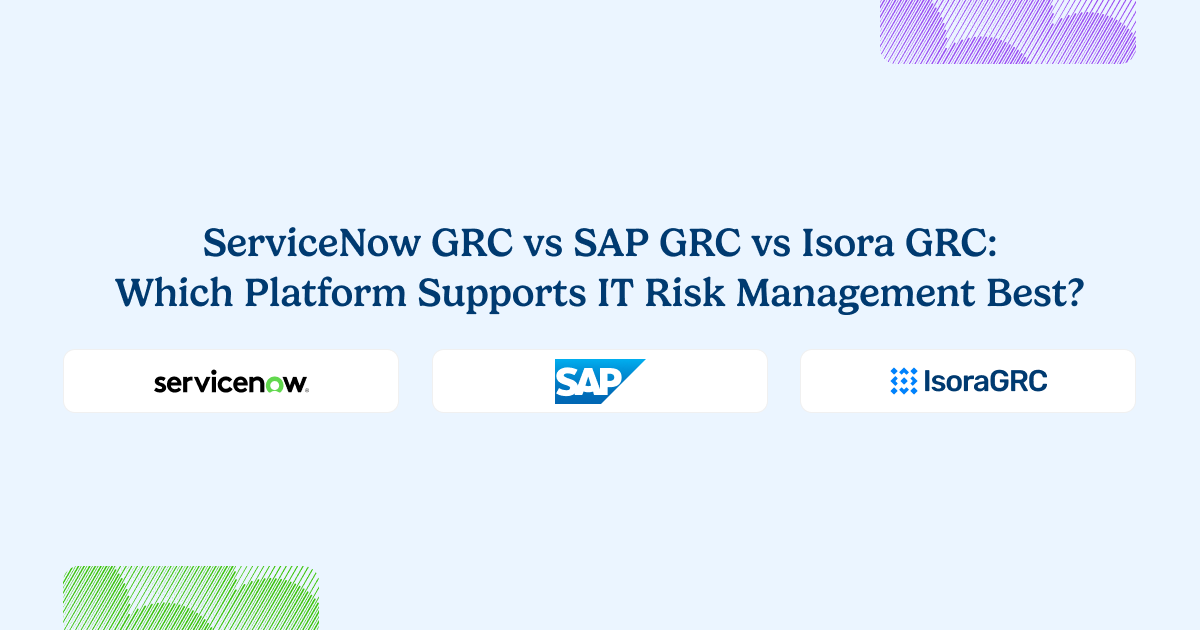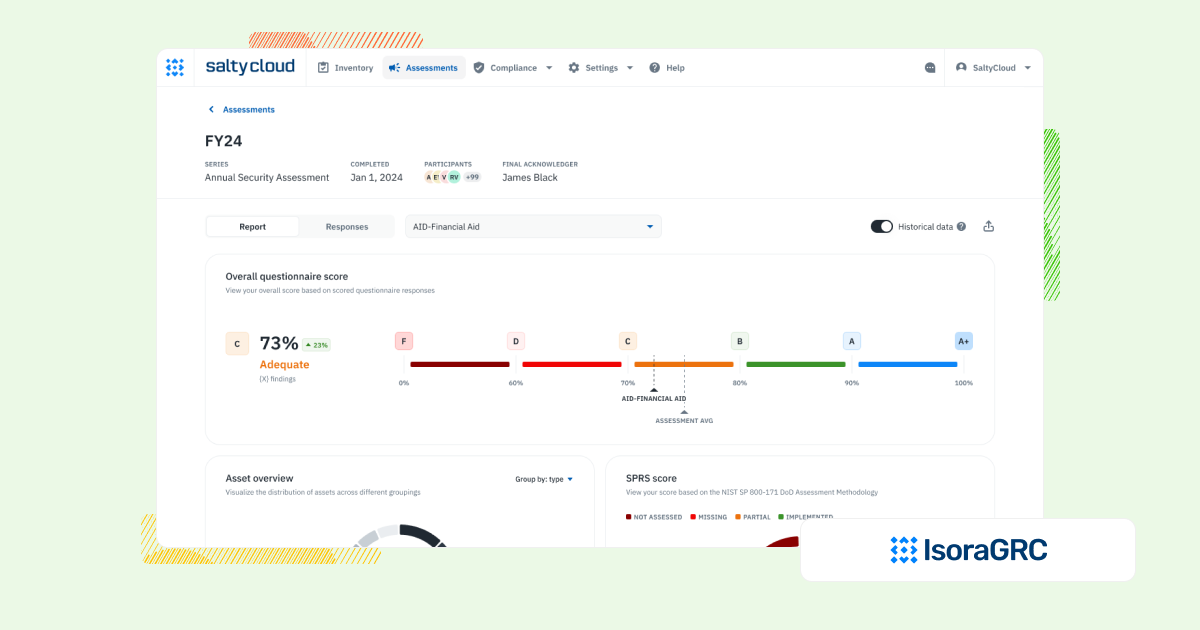
Every security team needs a practical, scalable way to manage IT risk without unnecessary complexity.
Platforms like ServiceNow GRC and SAP GRC deliver wide-ranging GRC capabilities, from compliance tracking to enterprise risk management.
But when a platform tries to cover everything, security teams are often left with too much complexity and not enough clarity. These systems can be slow to implement, difficult to tailor, and disconnected from the real-world workflows needed to manage IT risk day-to-day.
Isora GRC leads with a smarter method. It’s purpose-built for security teams who need to assess inventories, track risks, and manage vendors, without the heavy lift of traditional enterprise GRC tools.
Let’s analyze this in more detail.
Choosing the Right Platform for IT Risk Management
ServiceNow GRC is often positioned alongside broader IT operations, while SAP GRC is a legacy compliance powerhouse. Both provide powerful functionality—but they prioritize breadth and configuration flexibility over the clarity and speed security teams need.
Isora GRC was built specifically to support IT and third-party risk workflows. It offers structured, repeatable processes for assessments, vendor and asset inventories, exception tracking, and risk registers—delivered in a way that’s fast to deploy, intuitive to use, and easy to adopt across both technical and non-technical teams.
The Workflow That Matters: Managing IT Risks and Compliance
IT risk management is not a static checklist—it’s a dynamic, collaborative workflow. It requires gathering inputs from across internal teams and vendors, managing inventories, identifying and tracking risks, and driving remediation efforts over time.
Platforms built primarily for IT operations or compliance governance often struggle to support this type of real-world collaboration. Their complexity and rigid processes slow down the very work security teams are trying to streamline.
Isora GRC simplifies the risk management lifecycle—bringing assessments, inventories, exception tracking, and risk visibility into a single platform that teams can use daily without unnecessary friction.
How Each Platform Supports IT Risk Management Workflows
| Workflow Area | ServiceNow GRC | SAP GRC | Isora GRC |
| Assessment Management | ServiceNow GRC handles assessments, but setup takes time. Custom changes need skilled help, which can slow things down and raise costs. | The tools work, but the system feels too complex. Setting up workflows takes technical skill. Without that, work slows down. | Centralized, intuitive assessment dashboard across business units, vendors, and assets. Built specifically for security teams. |
| Questionnaire Delivery & Completion | Survey tools work, but the layout feels clunky for new users. Learning takes time, and some teams may avoid using the tools. | Survey tools feel basic and rigid. Making and managing forms takes a lot of manual work. Customizing them is tough. | Customizable and prebuilt questionnaires for frameworks like NIST, ISO, GLBA, HIPAA, and more. Designed for internal and external collaboration. |
| Inventory Tracking | Connecting ServiceNow GRC to old systems brings trouble. Upgrades may cost extra and slow the shift to the new system. | Tracking feels basic. Real-time updates don’t work well. Linking with other systems is limited, which hurts big teams the most. | Centralized tracking of assets, vendors, and organizational units with integration support for existing data sources. |
| Risk Register & Exception Management | Risk and exception tools run strong, but setup stays tough. Managing these tools may need extra teams, pulling time and money. | The risk register feels too simple. Custom setups don’t work well. Exception tracking takes too much manual effort and feels clunky. | Flexible, collaborative risk register with scoring, status, evidence, and ownership tied directly to assessments. Exception management is built-in and intuitive—no extra modules or configuration required. |
| Scoring, Reporting & Risk Visualization | Reports in ServiceNow can be tricky. Pulling data from different sources and making custom reports takes effort. This may slow down decisions. | Reports and scores exist but feel hard to use. Visuals need tech skill to build. Non-technical users often struggle. | Automated scorecards, risk maps, and executive-friendly reports with actionable insights—no manual config required. |
| Collaboration & User Experience | The layout feels heavy and hard to use. Learning takes time, so teams may need extra training to feel confident. | The design feels hard to use. Teams find it tough to work together in the system. Switching between modules causes frustration. | WCAG-compliant, award-nominated interface with built-in commenting, team workflows, and fast onboarding. |
| Implementation & Setup | Setting up ServiceNow GRC takes time, people, and money. License costs run high. Old systems may block a smooth shift and force more tech upgrades. | Setup takes time, money, and people. Small teams often struggle. Custom work takes a long time and adds extra cost. | No-code setup in days or weeks. Minimal IT lift required. Designed to go live quickly across teams and vendors. |
What Sets Isora GRC Apart?

Isora GRC was purpose-built for information security teams—designed to support the real workflows behind risk and compliance, not just generate reports. While legacy GRC platforms require months of configuration and rigid processes, Isora takes a modern, scalable approach:
- Purpose-built for security and third-party risk teams
- No extra modules or cross-department bloat—just the workflows that matter.
- Easy for anyone to use
- Clean UI, no complex training, and built to drive adoption across the org.
- Streamlined for action, not just documentation
- Assessments, questionnaires, inventories, risk tracking, and reporting—all in one place.
- Fast, no-code implementation
- Go live in weeks, not quarters, with minimal IT lift.
- Scales with your program
- Whether you’re running a lean risk function or supporting a large institution, Isora grows with you—without getting in the way.
Who Each Platform Is Best For
| Platform | Who It’s For |
| ServiceNow GRC | Companies already using ServiceNow. Helps tie risk and compliance into other business tools, but often feels built more for IT than security. |
| SAP GRC | Companies already deep in SAP. Helps track risk across business systems but feels old-school and hard to change. |
| Isora GRC | Security teams that need a scalable, usable IT risk management program across their organization. |
What Our Customers Say About Isora GRC
Security teams at top institutions are using Isora GRC to replace legacy tools and manual processes with intuitive workflows and actionable insight.
“Moving from manual processes to using Isora was a breath of fresh air. What used to take months is now automated, reliable, and defensible. Isora saves us significant time while delivering accurate insights that improve decision-making.”
Jessica Sandy, IT GRC Manager, The University of Chicago
“Isora has been essential in helping us meet our University of California cybersecurity requirements across a decentralized campus. Automating assessment data collection and reporting has given us clear visibility into unit-level risks, enabling us to prioritize resources effectively and address gaps with confidence.”
Allison Henry, CISO, The University of California, Berkeley
FAQs
What’s the difference between ServiceNow GRC, SAP GRC, and Isora GRC?
ServiceNow GRC and SAP GRC are large-scale platforms built to support enterprise governance, audit, and compliance functions. Isora GRC focuses specifically on IT and third-party risk workflows—streamlining assessments, inventories, and exception tracking for security teams.
Are ServiceNow GRC and SAP GRC considered all-in-one GRC platforms?
Yes. Both are designed for broad governance use across departments like audit, legal, and finance. This often leads to complex configuration and limited usability for teams focused on day-to-day risk operations.
Does Isora GRC replace platforms like ServiceNow or SAP GRC?
For security and vendor risk management, yes. Isora GRC provides the core workflows needed—without the overhead of building or maintaining cross-departmental systems.
Which platform is better for managing IT and vendor risk?
Isora GRC is built for that exact purpose. It enables fast deployment, supports collaborative assessments, and simplifies risk tracking across the organization, making it more accessible than traditional GRC suites.
Can Isora GRC be used alongside ServiceNow or SAP GRC?
Yes. Some organizations use Isora for operational IT risk while keeping broader GRC tools for regulatory or enterprise-level governance. Others transition to Isora fully to reduce complexity.
What should I look for in a GRC platform for security teams?
Focus on ease of use, adoption, and workflow alignment. Isora GRC supports assessments, questionnaires, inventories, and risk registers in a platform designed specifically for information security.



















 Other Relevant Content
Other Relevant Content